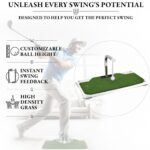
Choosing the Right Type of Golf Clubs
When it comes to choosing the right golf clubs, there are several factors to consider. Firstly, it’s important to determine what type of golfer you are. If you are a beginner, you may benefit from a more forgiving set of clubs, while more experienced players may require clubs tailored to their specific playing style.
Types of Golf Clubs
It’s essential to understand the different types of golf clubs available before making a purchase. There are four main types of golf clubs:
- Woods: These clubs are typically used for longer shots and have larger heads, allowing for greater distance.
- Irons: Irons are used for shots of varying distances, with lower numbers providing more distance and higher numbers for shorter shots.
- Wedges: Wedges are designed for shots close to the green, with different degrees of loft for different situations.
- Putters: Putters are used for shots on the green and are essential for accurate putting.
Consider Your Skill Level
Consider your skill level when choosing golf clubs. As a beginner, you may benefit from a more forgiving set of clubs with larger heads and more distance. More experienced players may require clubs tailored to their specific playing style.
Club Shaft Material
The material of the club shaft can significantly affect the performance of your golf clubs. There are three primary types of club shaft materials:
Steel
Steel shafts are durable and provide a consistent feel for most players. They are heavier than graphite shafts, which can help with swing consistency. Steel shafts are a popular choice for players who prefer a more traditional feel and control.
Graphite
Graphite shafts are lighter than steel shafts, which can help increase swing speed. They are also more flexible, providing better shock absorption and reducing strain on the arms and elbows. Graphite shafts are an excellent choice for players looking for increased distance and a softer feel.
Composite
Composite shafts are made from a combination of graphite and other materials, offering the benefits of both materials. They are designed to provide a balance of distance, feel, and control, making them a versatile option for a wide range of players.
Club Head Design
The design of the club head can greatly impact your performance on the golf course. Different club head designs offer distinct advantages, so it’s crucial to choose one that best suits your playing style and preferences.
Cavity Back
Cavity back club heads have a hollowed-out cavity behind the club face, redistributing weight around the perimeter of the club. This design provides forgiveness on off-center hits and helps launch the ball higher and straighter. Cavity back irons are ideal for beginners and high-handicap players who need more forgiveness on their shots.
Muscle Back
Muscle back club heads have a solid back without a cavity, placing the weight directly behind the club face. This design allows for more control and workability, making muscle back irons popular among skilled players looking for precision and shot-shaping capabilities.
Hybrid
Hybrid club heads combine the characteristics of both cavity back and muscle back designs, offering forgiveness, distance, and control in one club. Hybrid irons are suitable for a wide range of players, providing a good balance between forgiveness and playability.
Club Length
The length of your golf clubs can significantly impact your swing mechanics and shot consistency. Selecting the correct club length based on your height, arm length, and posture is essential for maximizing your performance on the course.
Standard Length
Most golf clubs come in standard lengths, which are suitable for the average height player. Standard length clubs are typically designed for players between 5’6″ and 6’0″ in height. If you fall within this height range, standard length clubs may be suitable for you.
Longer Length
Players who are taller than 6’2″ may benefit from longer clubs to accommodate their height. Longer clubs can help prevent you from hunching over and provide a more comfortable and natural swing motion. If you find yourself bending down excessively with standard length clubs, longer clubs may be the solution.
Custom Length
For players who fall outside of the standard height range, custom length clubs may be necessary. Custom clubs can be tailored to your specific height, arm length, and posture, ensuring that you have the correct club length for optimal performance. Custom clubs are especially beneficial for players with unique physical characteristics that require personalized equipment.
Club Grip Size
The grip size of your golf clubs plays a crucial role in your ability to control the club and make consistent shots. Choosing the right grip size based on your hand size and preference can enhance your feel and performance on the course.
Standard Grip Size
Standard grip size is the most common option and is suitable for the average hand size. If you have medium-sized hands, standard grip size clubs may work well for you. Standard grip size provides a good balance of feel and control for most players.
Oversized Grip Size
Oversized grip size can be beneficial for players with larger hands or those who struggle with grip pressure. Oversized grips provide more surface area for gripping the club, reducing tension in the hands and promoting a more relaxed grip. If you find that standard grips feel too small or uncomfortable, oversized grips may be worth trying.
Undersized Grip Size
Undersized grip size is suitable for players with smaller hands who have difficulty controlling the club with standard grips. Undersized grips allow for a more secure grip and increased control, making them ideal for golfers with petite hands. If standard grips feel too large or unwieldy, undersized grips may be worth considering.
Club Set Configuration
The configuration of your golf club set can vary depending on your playing style, skill level, and course conditions. Understanding the different options available and how they can affect your performance can help you select the right set configuration for your needs.
Full Set
A full set of golf clubs typically includes a driver, fairway woods, hybrids, irons, wedges, and a putter. Full sets are suitable for players looking for versatility and performance across all areas of the course. If you’re a beginner or intermediate player, a full set can provide you with the necessary clubs to improve your game.
Half Set
A half set of golf clubs includes fewer clubs than a full set, focusing on the essentials for playing a round of golf. Half sets typically consist of a driver, a couple of irons, a wedge, and a putter. Half sets are ideal for players looking to simplify their club selection and focus on the essentials for their game.
Custom Configuration
Custom club set configurations allow you to tailor your clubs to your specific playing style and preferences. You can mix and match different types of clubs to create a set that suits your needs, such as adding additional wedges or hybrids to enhance your short game. Custom configurations are suitable for advanced players looking to optimize their equipment for maximum performance.
Club Fitting
Club fitting is a critical part of the golf club buying process, as it ensures that your clubs are properly suited to your physical characteristics and swing mechanics. Getting a professional club fitting can help you optimize your performance, improve your shot consistency, and prevent injury.
Accuracy
A club fitting session involves testing your swing with various clubs and shaft options to determine which ones produce the most accurate and consistent results. By analyzing your ball flight, swing speed, and impact location, a club fitter can recommend the best club specifications for your game.
Comfort
Comfort is essential when selecting golf clubs, as discomfort or awkwardness in your equipment can negatively affect your performance. A club fitting session can identify the correct club length, grip size, and shaft material that will enhance your comfort and confidence on the course.
Performance
The primary goal of a club fitting is to improve your overall performance and optimize your shot-making abilities. By customizing your clubs to fit your swing characteristics and physical attributes, you can maximize distance, control, and accuracy in every shot you make.
Conclusion
Choosing the right golf clubs can significantly impact your performance on the course and enhance your overall golfing experience. By considering factors such as club type, shaft material, club head design, club length, grip size, set configuration, and club fitting, you can select the perfect set of clubs tailored to your playing style and preferences. Remember to take your time, do your research, and consult with golf professionals to make informed decisions when buying golf clubs. Happy golfing!





